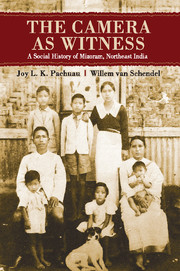Book contents
- Frontmatter
- Contents
- List of Figures
- List of Maps
- Acknowledgements
- I Becoming Mizo
- 1 Introduction
- 2 Coming into View: The First Portraits
- 3 Adjusting Mizo Culture
- 4 Domesticating a New Religion
- 5 Getting Educated
- 6 Controlling the Hills
- 7 The Trouble of Travel
- 8 First Stirrings of the Market Economy
- 9 Mizos in the World Wars
- 10 Mizo Visual Sensibilities
- II Mizoram in the New India
- III Visions of Independence
- IV Mizo Modernities
- Copyrights and Sources
- Glossary
- Bibliography
- Index
7 - The Trouble of Travel
from I - Becoming Mizo
Published online by Cambridge University Press: 05 May 2015
- Frontmatter
- Contents
- List of Figures
- List of Maps
- Acknowledgements
- I Becoming Mizo
- 1 Introduction
- 2 Coming into View: The First Portraits
- 3 Adjusting Mizo Culture
- 4 Domesticating a New Religion
- 5 Getting Educated
- 6 Controlling the Hills
- 7 The Trouble of Travel
- 8 First Stirrings of the Market Economy
- 9 Mizos in the World Wars
- 10 Mizo Visual Sensibilities
- II Mizoram in the New India
- III Visions of Independence
- IV Mizo Modernities
- Copyrights and Sources
- Glossary
- Bibliography
- Index
Summary
Moving around the hill country was never easy. It was a land of steep slopes covered with dense vegetation and separated by precipitous gorges. At least 70 per cent of Mizoram's land area is sloped at angles steeper than 33°. This is how a British official described the Mizoram landscape in the 1880s: ‘The country is almost unexplored, and very little is known of it, except that it is a tract of most intricate hill ranges and impenetrable cane-brakes … On the edges of this tract on all sides the hills are low, covered with dense forest and trackless jungle, the only paths being for the most part the beds of torrents’. Each hilltop village needed access to the outside world but also to a source of water. Every morning women would go down to the nearest spring or brook to fetch water in large bamboos or gourds, an essential and very arduous task (Figure 7.1). Village agricultural fields were often far from the settlement – and other daily activities, such as hunting, also required villagers to cover considerable distances.
A land of walkers
People did not use animals or wheeled transport to get around. Instead they walked. A web of narrow trails crisscrossed the hills. The inhabitants of this land of walkers were well adapted to their rugged, precipitous surroundings. Figure 7.2 shows a group of men, carrying the possessions of an early missionary, who are coming down a steep path in 1913. By that time some new roads were already being constructed but ‘they often prefer travelling along these paths as they are more used to them than they are to the more level Government Road’. As the Mizo saying goes: ‘The right path is very steep and difficult to climb while the wrong path is horizontal and easy’. British travellers, on the other hand, had great trouble with these paths: Lushai is a terrible place for boots.
- Type
- Chapter
- Information
- The Camera as WitnessA Social History of Mizoram, Northeast India, pp. 145 - 167Publisher: Cambridge University PressPrint publication year: 2015

